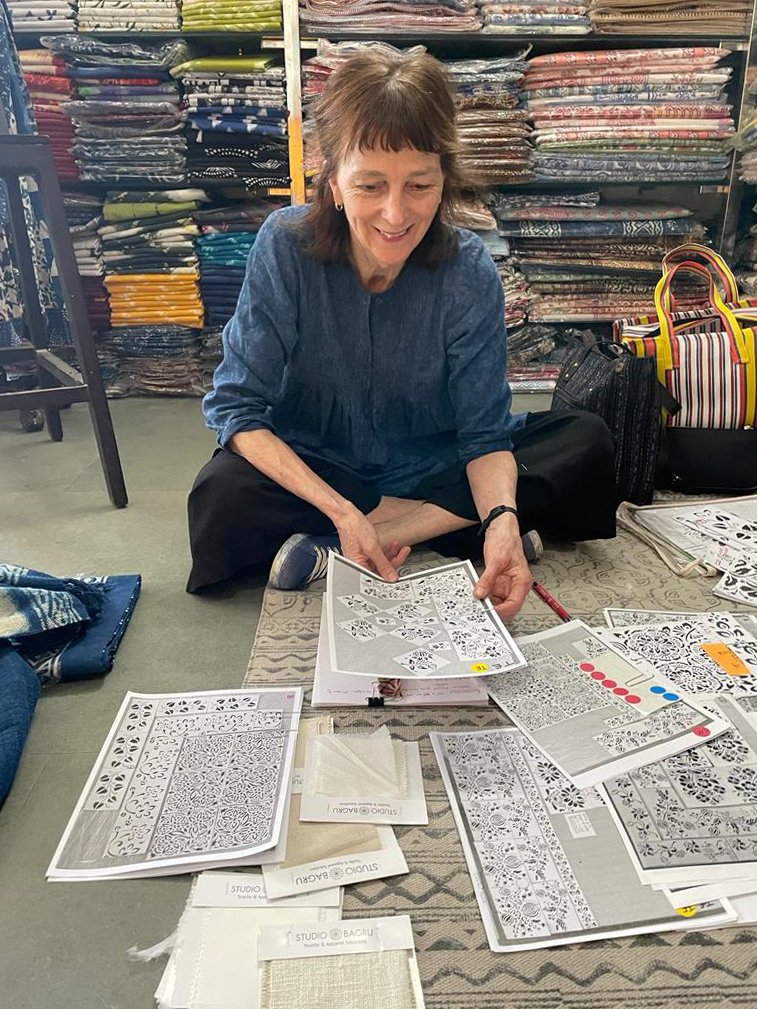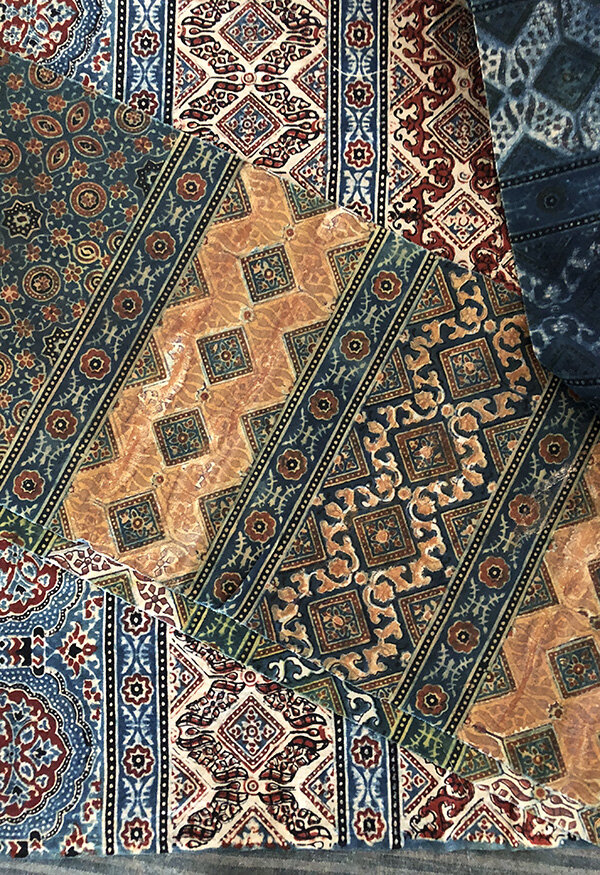Process
Design
Designing begins with developing an original motif, and inspiration can be found in many forms: for example, a 10th century cloth fragment from India, perhaps a faded suggestion of a leaf or a flower upon which I can expand. From there, I will make several drawings, transforming line and shape into lyrical interpretations. The final drawing is traced onto mylar and then cut into a durable stencil. The fabric, undyed or dyed, is affixed to the studio table and is ready for the application of the stencils. There may be as many as six stencils skillfully applied to the surface, sometimes the layout of the composition is deliberate, sometimes unplanned.
Printing and Dyeing
Organic Indigo
I have long been captivated by the complex dyeing process associated with natural indigo extract, an exotic dyestuff with a fascinating history. Indigo, from fresh leaves to ground sediment, imparts a palpable aura of transient beauty. Subtle shifts of color are inherent and valued in the craft of any hand dyed artistry and with indigo this is especially true. My studio usually has several active indigo vats made up of different organic recipes waiting to receive fabric. My favorites are the fructose (sugar) vat and the ferrous sulfate (iron) vat.
Depending on variations in ingredients, temperature and time, an indigo vat will produce an extraordinarily beautiful range of blues. A sugar vat will produce the palest blues, considered by master indigo dyers to be the most difficult to achieve. An iron vat may yield rich mineral blues. The surfaces of my indigo textiles such as the Tapestry Table Runners are reminiscent of light shimmering on water or evoke the deepest blue of a mysterious night sky. Undulating layers of color and imprinted designs impart a sense of peace and calm.
Clay resist printing on fabric has an ancient and enduring relationship with the indigo dye vat. In India, mud scraped from the river banks is typically used for making the resist. I make the clay resist paste in my studio combining several types of powdered clay with a binder. I then stencil the resist onto the fabric, let it dry, and then dip the fabric repeatedly, into the dye vat. The dried clay paste prevents the indigo from penetrating into the stenciled areas, in effect “resisting” the dye. Sometimes the clay paste will wander outside the stenciled imprint, adding another layer of serendipitous markings.
Natural Dyes
Natural dyes are dyestuffs obtained from plants and insects. I work with plant based dyes. The process of dyeing with plants involves alchemy, intuition and patience as many steps, often over a dozen, are required to achieve the exquisite result. Fabric is slowly transformed through complex molecular reactions. Ancients dyestuffs such as madder, cutch, pomegranate, myrobalan and indigo are mixed carefully in the studio for the dye baths and/or as print paste for stenciling. The colors are rich, yet subtle, with inherent variations in shades. The Darling Cocktail Napkin dyed with myrobalan and printed with cutch on linen is inspired by textiles traded centuries ago along the Silk Road.
Azo-free Dyes
Azo-free dyes are brilliant nontoxic dyes which are colorfast and long-lasting. They allow me to broaden my palette and to work on a larger scale especially with luxuriously heavy linen such as I use for The Gathering Tablecloths. I mix my own colors, influenced by traditional Indian natural dyes: cutch (browns), madder (reds), indigo (blues), and saffron (yellows). After the fabric is dyed, it is stenciled with carefully mixed print pastes. Alternatively, another technique consists of applying a nontoxic resist paste which discharges the dye only in the stenciled areas. I love this technique and employ it often as you’ll notice in the Plein Air Picnic Cloths.
Materials
Antonia Textiles sources ethically grown and produced materials whenever possible. All linen is imported from Europe. Organic cottons are from India and the whispery silks are from China. Natural indigo extract comes from organic independent farms in India and the USA. All other natural dyestuffs are grown in different parts of Asia and Central America.
Care of your Antonia Textile
Organic Indigo
As with any heirloom textile, an indigo dyed fabric should be treated with care. Our instructions are easy to follow. You may find the dye may rub off, a process known as “crocking,” or during the first few washes your wash water may be slightly tinted. This is normal! Crocking or leaching of dye will stop after a wash or two. Always hand wash your indigo separately and delicately using cold water with Ivory liquid soap. Indigo dye may fade in strong sunlight so always line dry or lay flat, in the shade. Ironing is optional and should be on the proper fabric setting. Indigo also may simply fade over time but this only adds to its beauty. Properly cared for, your indigo treasure will last forever.
Natural and Azo-Free Dyes
Care of all other non-indigo dyed fabrics is simple and easy to follow. Always hand wash separately and delicately using cold water with a neutral PH gentle liquid soap. Natural dyes may run a little during first few washes. This is normal and will not affect the textile. Line dry or lay flat and if the item is linen, you may gently reshape when damp. Ironing is optional and should be on the proper fabric setting.
Gathering Tablecloths which are large and of heavier linen should always be hand washed unless otherwise specified on the label. Azo-free dye textiles may, if specified on label, be machine washed separately, cold water, gentle pH neutral liquid soap on the most delicate cycle. Line dry always. Dry cleaning is not recommended for heirloom textiles.












